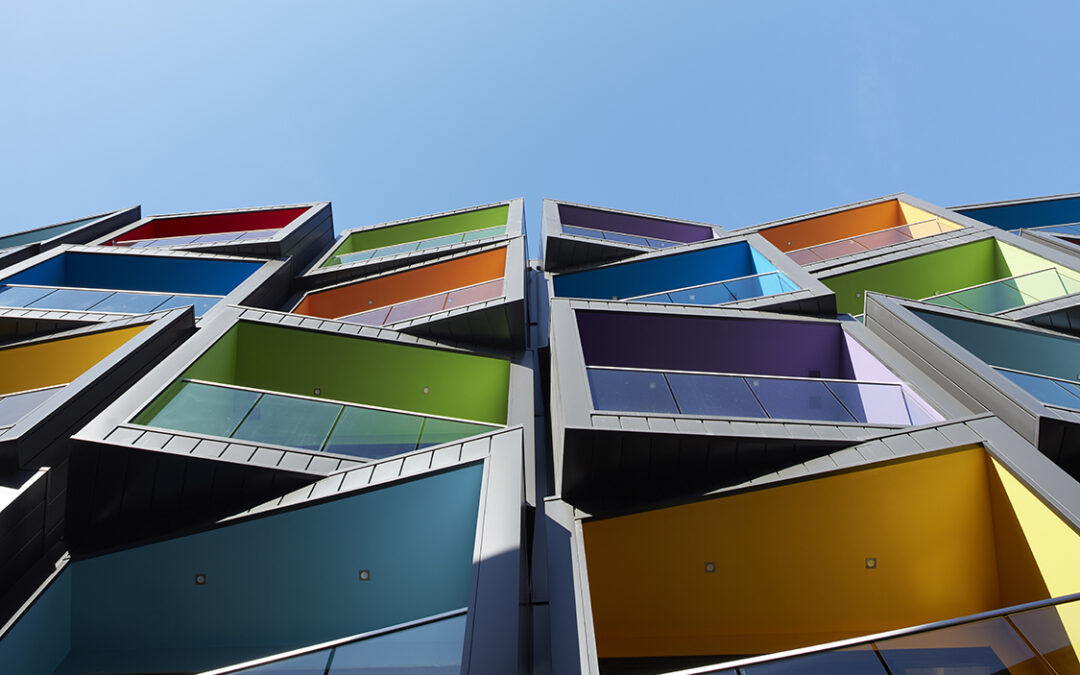Have you noticed that apartment building design in the United States has become unremarkable and highly predictable? We have! A basic stacking of boxes with minimal vision and complete disconnect from the environment has taken the place of innovation and sustainable design.
The lackluster apartment buildings in modern US cities not only looks out of place (in both time and space), but it also doesn’t fit the lifestyle of modern day city-dwellers.
It’s time to break out of the ‘box’!
Apartment building design should be about creating a larger environment, and not about merely dividing one big box into smaller boxes. All elements of the design should work together in perfect harmony to create a space that not only gives its occupants a place to call home, but also connects them to the natural environment and to their community.
Here is our list of the 5 most important and grossly underused solutions for breaking out of the ‘box’.
- Prioritize Sustainability
- Complement the Surrounding Neighborhood
- Create a sense of Openness
- Integrate Social Spaces throughout the buildings (not merely at street level)
- Maximize usable Outdoor Space.
There are many great examples of apartment building designs all around the World that have broken free from the box and created beautiful environment. Here are some of our favorite examples – three apartment buildings that we admire for their creative solutions to complex social and environmental problems, their awe inspiring design and their innovative use of the natural environment.
Safie’s Golden Dream Bay
‘The demand for quality, affordable housing in Asia’s growing cities has allowed us to apply the principles that informed habitat 67 on a grand scale,’ said Moshe Safdie. ‘The increased density of today’s cities requires us to rethink building types to maintain a sense of community, while ensuring privacy and private outdoor space. By breaking down the megascale, we aren’t building units; we’re building homes. Golden dream bay offers a new model for high density housing, one where the level of amenities surpasses that of the typical high-rise complex, without sacrificing the structure’s efficiency or humanity.’
The complex consists of a series of individual 15-story slab buildings that connect and stack vertically, in two tiers, rising to 30 stories. The buildings are staggered, with units arranged in a stepped pattern, which creates ‘skyways’ at the 16th and 30th levels. Each unit has maximum exposure, and a majority of apartments contain terraces and gardens. By sitting the tower blocks north-south, together with the stepped profile, the solution maximizes construction efficiency, and maintains the benefits of the individual dwelling with terraces, skylights, and solariums.
Kavellaris Spectrum Apartments
From the KUD website:
Spectrum Apartments is situated on a site with three frontages. It was critical that the architecture address and activate all three frontages but also be of a single architectural language.
The project is expressed as strips of building mass to exemplify the diverse cultural context of Box Hill. The “strips” geometrically alternate over the floor plates to create highly articulated façades. The terminations of the “Strips” are expressed with brightly coloured fascia around the balconies, adding a vibrant presence to the public realm.
To increase the public amenity of the occupants of the apartment, the internal circulation areas are open to the sky, acting as a “lung” to the development. This “lung” would provide for additional daylighting and natural ventilation while allowing for vegetation to populate the open atrium.
“8 House is a three-dimensional neighborhood rather than an architectural object. An alley of 150 rowhouses stretches through the entire block and twists all the way from street level to the top and down again. Where social life, the spontaneous encounter and neighbor interaction traditionally is restricted to the ground level, the 8 House allows it to expand all the way to the top,” Bjarke Ingels, Founding Partner, BIG.
“The apartments are placed at the top while the commercial program unfolds at the base of the building. As a result, the different horizontal layers have achieved a quality of their own: the apartments benefit from the view, sunlight and fresh air, while the office leases merge with life on the street. This is emphasized by the shape of 8 House which is literally hoisted up in the Northeast corner and pushed down at the Southwest corner, allowing light and air to enter the southern courtyard,” Thomas Christoffersen, Partner in Charge, 8 House, BIG.
From the BIG’s website:
The 8 House has two sloping green roofs totaling over 18,000sf, which are strategically placed to reduce the urban heat island effect as well as to visually tie it back to the adjacent Farmlands towards the South. The shape of the building allows for daylight and natural ventilation for all units. In addition, rainwater is collected and repurposed through a stormwater management system.
